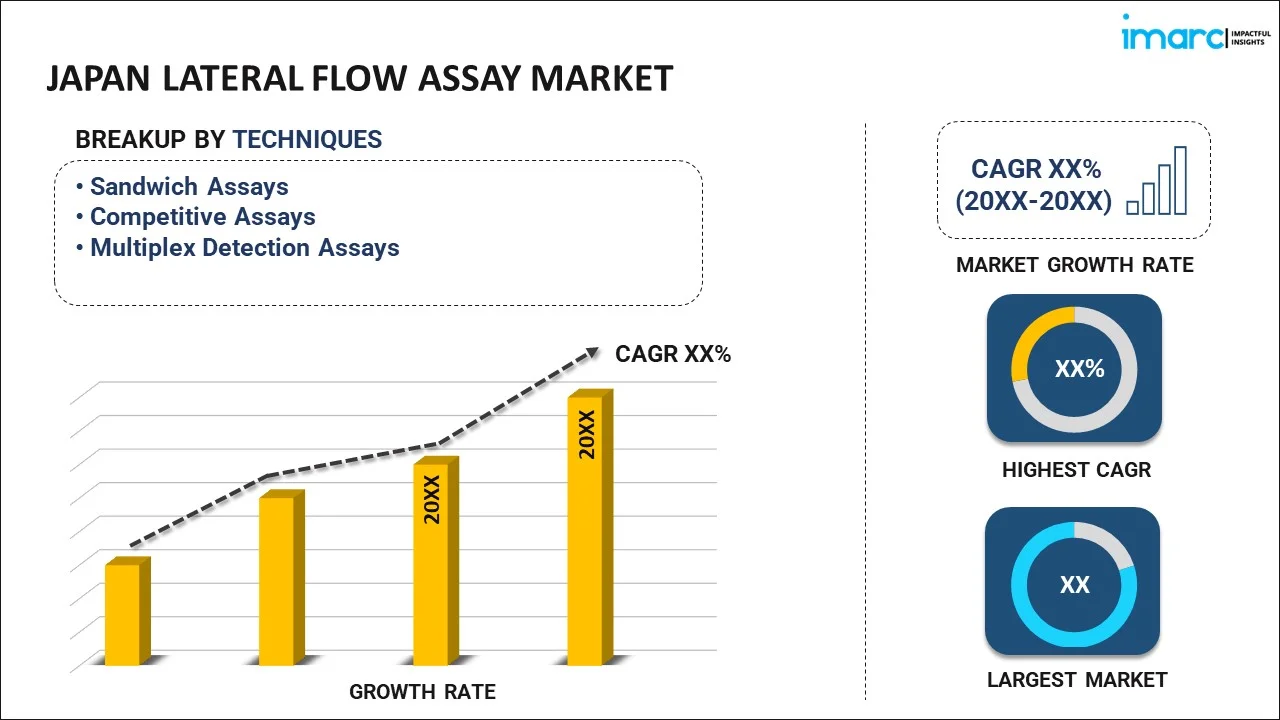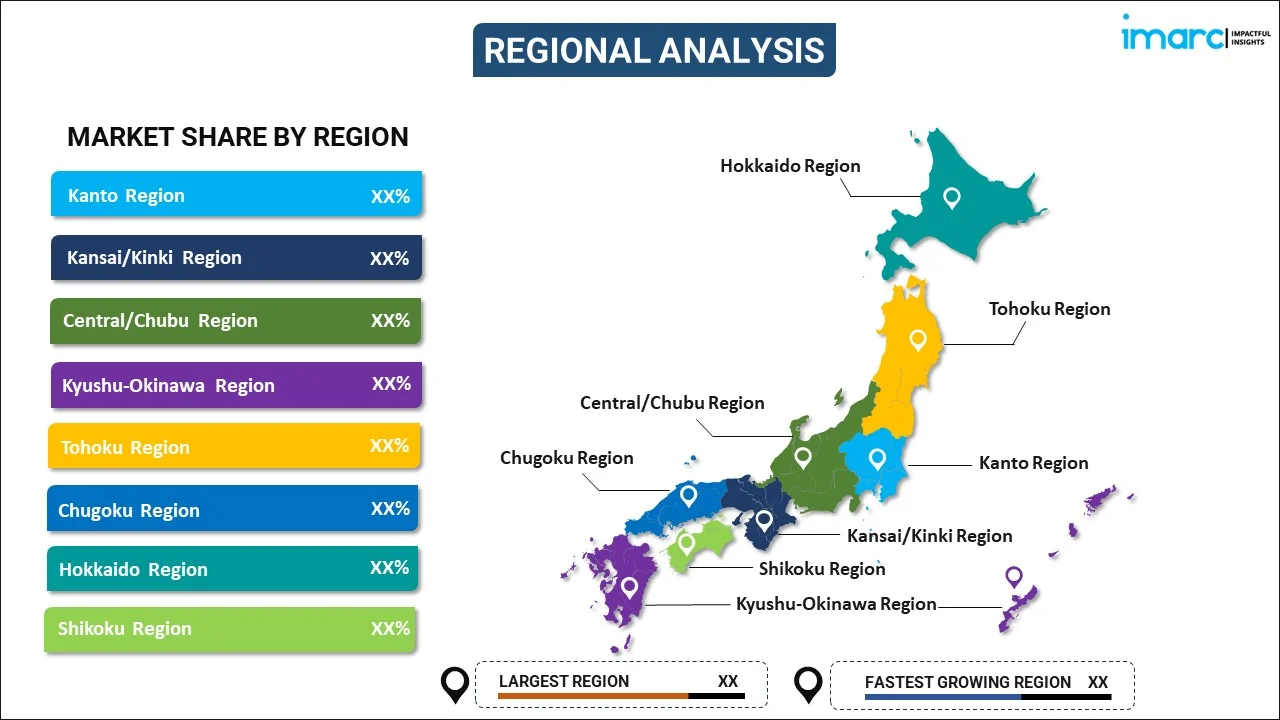
Japan Lateral Flow Assay Market Report by Technique (Sandwich Assays, Competitive Assays, Multiplex Detection Assays), Product (Kits and Reagents, Lateral Flow Readers), Application (Clinical Testing, Veterinary Diagnostics, Food Safety and Environment Testing, Drug Development and Quality Testing), End User (Hospitals and Clinics, Diagnostic Laboratories, Home Care, Pharmaceutical and Biotechnology Companies, and Others), and Region 2025-2033
Market Overview:
Japan lateral flow assay market size reached USD 882.8 Million in 2024. Looking forward, IMARC Group expects the market to reach USD 1,402.8 Million by 2033, exhibiting a growth rate (CAGR) of 5.3% during 2025-2033. The increasing prevalence of infectious diseases, the growing demand for point-of-care testing (POCT) solutions, the rapid advancements in lateral flow assay technology, the rising regulatory approvals, and the escalating health initiatives and awareness campaigns are some of the factors propelling the market.
|
Report Attribute
|
Key Statistics
|
|---|---|
|
Base Year
|
2024 |
|
Forecast Years
|
2025-2033 |
|
Historical Years
|
2019-2024
|
| Market Size in 2024 | USD 882.8 Million |
| Market Forecast in 2033 | USD 1,402.8 Million |
| Market Growth Rate (2025-2033) | 5.3% |
Lateral Flow Assay (LFA), a widely used diagnostic technique, operates by capillary action, allowing the rapid detection of specific analytes in biological samples. In this assay, a sample is applied to one end of a test strip containing immobilized capture reagents and signal-generating elements. As the sample migrates across the strip, it interacts with these components, forming visible test and control lines. LFA's active principle lies in its simplicity and quick results, making it ideal for point-of-care testing. The analyte's presence is indicated by a visible line, enabling users to assess results without the need for complex instrumentation. With applications ranging from infectious disease testing to pregnancy diagnostics, LFAs continue to gain prominence due to their user-friendly nature, rapid response times, and adaptability to diverse testing environments. As the demand for accessible and efficient diagnostic solutions persists, the active deployment of lateral flow assays contributes significantly to the evolution of rapid and point-of-care testing in various healthcare settings.
Japan Lateral Flow Assay Market Trends:
The market in Japan is majorly driven by the increasing emphasis on advanced healthcare solutions and diagnostics. LFAs, with their simplicity, speed, and effectiveness, align perfectly with the Japanese healthcare system's focus on providing timely and accessible diagnostics. As the country faces an aging population and an increase in chronic diseases, quick and efficient point-of-care testing becomes paramount, contributing significantly to the growing adoption of LFAs. Furthermore, the global impact of infectious diseases, highlighted by events like the COVID-19 pandemic, has underscored the importance of rapid and accurate diagnostic tools. LFAs, being instrumental in the detection of various infectious agents, including viruses and bacteria, are gaining traction in Japan's efforts to strengthen its diagnostic capabilities. The versatility of LFAs in detecting a range of analytes, from pathogens to biomarkers, positions them as valuable tools in managing public health challenges. Besides, the healthcare sector's inclination toward preventive care and early diagnosis further propels the market growth of LFAs. The adaptability of LFAs to various healthcare settings, including clinics, pharmacies, and remote locations, aligns well with Japan's commitment to expanding access to healthcare services across diverse demographics. Additionally, the collaboration between the Japanese government, research institutions, and healthcare providers in advancing diagnostic technologies creates a conducive environment for the adoption of LFAs. As the demand for rapid and reliable diagnostics continues to rise in Japan, driven by demographic shifts and evolving healthcare priorities, the market is poised for sustained growth, playing a vital role in enhancing the efficiency and accessibility of diagnostic testing throughout the country.
Japan Lateral Flow Assay Market Segmentation:
IMARC Group provides an analysis of the key trends in each segment of the market, along with forecasts at the country level for 2025-2033. Our report has categorized the market based on technique, product, application, and end user.
Technique Insights:

- Sandwich Assays
- Competitive Assays
- Multiplex Detection Assays
The report has provided a detailed breakup and analysis of the market based on the technique. This includes sandwich assays, competitive assays, and multiplex detection assays.
Product Insights:
- Kits and Reagents
- Lateral Flow Readers
- Digital/Mobile Readers
- Benchtop Readers
A detailed breakup and analysis of the market based on the product have also been provided in the report. This includes kits and reagents and lateral flow readers (digital/mobile readers and benchtop readers).
Application Insights:
- Clinical Testing
- Infectious Disease Testing
- Cardiac Marker Testing
- Pregnancy and Fertility Testing
- Cholesterol Testing/Lipid Profile
- Drug Abuse Testing
- Others
- Veterinary Diagnostics
- Food Safety and Environment Testing
- Drug Development and Quality Testing
The report has provided a detailed breakup and analysis of the market based on the application. This includes clinical testing (infectious disease testing, cardiac marker testing, pregnancy and fertility testing, cholesterol testing/lipid profile, drug abuse testing, and others), veterinary diagnostics, food safety and environment testing, and drug development and quality testing.
End User Insights:
- Hospitals and Clinics
- Diagnostic Laboratories
- Home Care
- Pharmaceutical and Biotechnology Companies
- Others
A detailed breakup and analysis of the market based on the End User have also been provided in the report. This includes hospitals and clinics, diagnostic laboratories, home care, pharmaceutical and biotechnology companies, and others.
Regional Insights:

- Kanto Region
- Kansai/Kinki Region
- Central/ Chubu Region
- Kyushu-Okinawa Region
- Tohoku Region
- Chugoku Region
- Hokkaido Region
- Shikoku Region
The report has also provided a comprehensive analysis of all the major regional markets, which include Kanto Region, Kansai/Kinki Region, Central/ Chubu Region, Kyushu-Okinawa Region, Tohoku Region, Chugoku Region, Hokkaido Region, and Shikoku Region.
Competitive Landscape:
The market research report has also provided a comprehensive analysis of the competitive landscape. Competitive analysis such as market structure, key player positioning, top winning strategies, competitive dashboard, and company evaluation quadrant has been covered in the report. Also, detailed profiles of all major companies have been provided.
Japan Lateral Flow Assay Market Report Coverage:
| Report Features | Details |
|---|---|
| Base Year of the Analysis | 2024 |
| Historical Period | 2019-2024 |
| Forecast Period | 2025-2033 |
| Units | Million USD |
| Scope of the Report | Exploration of Historical and Forecast Trends, Industry Catalysts and Challenges, Segment-Wise Historical and Predictive Market Assessment:
|
| Techniques Covered | Sandwich Assays, Competitive Assays, Multiplex Detection Assays |
| Products Covered |
|
| Applications Covered |
|
| End Users Covered | Hospitals and Clinics, Diagnostic Laboratories, Home Care, Pharmaceutical and Biotechnology Companies, Others |
| Regions Covered | Kanto Region, Kansai/Kinki Region, Central/ Chubu Region, Kyushu-Okinawa Region, Tohoku Region, Chugoku Region, Hokkaido Region, Shikoku Region |
| Customization Scope | 10% Free Customization |
| Post-Sale Analyst Support | 10-12 Weeks |
| Delivery Format | PDF and Excel through Email (We can also provide the editable version of the report in PPT/Word format on special request) |
Key Questions Answered in This Report:
- How has the Japan lateral flow assay market performed so far and how will it perform in the coming years?
- What has been the impact of COVID-19 on the Japan lateral flow assay market?
- What is the breakup of the Japan lateral flow assay market on the basis of technique?
- What is the breakup of the Japan lateral flow assay market on the basis of product?
- What is the breakup of the Japan lateral flow assay market on the basis of application?
- What is the breakup of the Japan lateral flow assay market on the basis of end user?
- What are the various stages in the value chain of the Japan lateral flow assay market?
- What are the key driving factors and challenges in the Japan lateral flow assay?
- What is the structure of the Japan lateral flow assay market and who are the key players?
- What is the degree of competition in the Japan lateral flow assay market?
Key Benefits for Stakeholders:
- IMARC’s industry report offers a comprehensive quantitative analysis of various market segments, historical and current market trends, market forecasts, and dynamics of the Japan lateral flow assay market from 2019-2033.
- The research report provides the latest information on the market drivers, challenges, and opportunities in the Japan lateral flow assay market.
- Porter's five forces analysis assist stakeholders in assessing the impact of new entrants, competitive rivalry, supplier power, buyer power, and the threat of substitution. It helps stakeholders to analyze the level of competition within the Japan lateral flow assay industry and its attractiveness.
- Competitive landscape allows stakeholders to understand their competitive environment and provides an insight into the current positions of key players in the market.
Need more help?
- Speak to our experienced analysts for insights on the current market scenarios.
- Include additional segments and countries to customize the report as per your requirement.
- Gain an unparalleled competitive advantage in your domain by understanding how to utilize the report and positively impacting your operations and revenue.
- For further assistance, please connect with our analysts.
 Inquire Before Buying
Inquire Before Buying
 Speak to an Analyst
Speak to an Analyst
 Request Brochure
Request Brochure
 Request Customization
Request Customization




.webp)




.webp)












